|
Rolls-Royce Phantom
Debut: 2003
Maker: Rolls-Royce
Predecessor: Silver Seraph
|
|
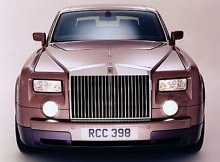 On
January 1st, legendary British luxurious brand Rolls-Royce shifted
ownership
from Volkswagen group to BMW. The new generation, BMW-developed,
Goodwood-built
Rolls-Royce Phantom was also launched at the same time. Rolls-Royce
entered
a new era. On
January 1st, legendary British luxurious brand Rolls-Royce shifted
ownership
from Volkswagen group to BMW. The new generation, BMW-developed,
Goodwood-built
Rolls-Royce Phantom was also launched at the same time. Rolls-Royce
entered
a new era.
In response to
those who
doubt the identity of the reborn Rolls-Royce - is it really British? or
actually a BMW 9-series with a RR badge? - BMW took special care during
the 4 and a half year preparation. Firstly, they set up a studio in
London
and employed British Ian Cameron as design chief of the project. Then
they
built a factory in Goodwood of England - the place famous for classic
car
festival - and employed skillful British craftsmen for their wood and
leather
workshops.
From
the
pictures, I am amazed
by how retro the Phantom looks. It seems the team led Cameron
deliberately
injected a lot of, or even too much Rolls-Royce-ness into the new car.
For example, the square RR-corporate grille is considerably larger than
that of the outgoing Silver Seraph, so large that it feels quite
imposing
to eyes. The body profile also delivers a sense of heavyweight and
security
(or bulky, if you don’t like it) like some older RR, more so than the
Silver
Seraph. Ridiculously, Silver Seraph looked advancer than the new
car.
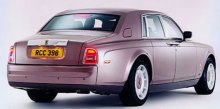 The
Phantom is undoubtedly a very big car, lying between Maybach 57 and
Maybach
62. For example, its 3570mm wheelbase is longer than Maybach 57’s
3390mm
and shorter than 62’s 3827mm. However, you may notice the Rolls-Royce
is
very wide and tall. In fact, it is slightly wider than Maybach and its
height exceeds the latter by a massive 60mm. (We shall explain why it
needs
to be so tall later) Therefore it is very heavy, tipping the scale at
2485kg,
some 200kg more than Silver Seraph. However, Maybachs are even heavier
- from 2660 to 2780kg. The
Phantom is undoubtedly a very big car, lying between Maybach 57 and
Maybach
62. For example, its 3570mm wheelbase is longer than Maybach 57’s
3390mm
and shorter than 62’s 3827mm. However, you may notice the Rolls-Royce
is
very wide and tall. In fact, it is slightly wider than Maybach and its
height exceeds the latter by a massive 60mm. (We shall explain why it
needs
to be so tall later) Therefore it is very heavy, tipping the scale at
2485kg,
some 200kg more than Silver Seraph. However, Maybachs are even heavier
- from 2660 to 2780kg.
What
made
Rolls-Royce lighter
than its arch-rival Maybach is the use of aluminum space frame chassis
instead of steel monocoque. The chassis is constructed from aluminum
extrusions,
castings and pressed aluminum sheets mainly, with steel front subframe
and aluminum rear subframe for mounting suspensions. Most exterior
panels
are aluminum, except the composite front wings and steel boot lid. The
whole body-in-white weighs 550kg, compare with Maybach’s 622kg. This
seems
not very remarkable for an aluminum space frame chassis, but you should
notice that the chassis of Phantom achieves a super-high torsional
rigidity
of 40,500Nm/degree. A few months ago, Volkswagen claimed its Phaeton
was
the stiffest in the world, at 37,000Nm/degree. For comparison, an Opel
Vectra is 18,000Nm/degree only.
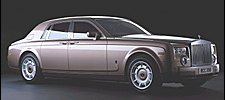 ASF
is very suitable to small-scale production - RR plans to build only
1,000
Phantoms annually, the same as Maybach. In contrast, steel monocoque
chassis
needs expensive press machines thus is less cost-effective for small
volume.
In fact, BMW’s ASF technology was first introduced and experimented in
the Z8 roadster. Therefore the chassis of Phantom is also built in the
same factory in Germany. Engine and most mechanicals are also produced
in Germany, then ship to Goodwood for final assembly, crafting the
wood-and-leather
interior, painting etc. ASF
is very suitable to small-scale production - RR plans to build only
1,000
Phantoms annually, the same as Maybach. In contrast, steel monocoque
chassis
needs expensive press machines thus is less cost-effective for small
volume.
In fact, BMW’s ASF technology was first introduced and experimented in
the Z8 roadster. Therefore the chassis of Phantom is also built in the
same factory in Germany. Engine and most mechanicals are also produced
in Germany, then ship to Goodwood for final assembly, crafting the
wood-and-leather
interior, painting etc.
Predictably,
many
critical
mechanical components are sourced from BMW. The V12 engine is derived
from
760Li’s, with capacity enlarged to the magic number of 6.75 litres. It
still has the long list of technology, such as Double-Vanos VVT,
variable
exhaust, Valvetronic and direct-injection which allows 11.0:1
compression
ratio. These enable a maximum output of 460 horsepower at 5350rpm,
slightly
more than that of 760Li. However, the focus is on torque - with both
stroke
and intake manifold longer than the BMW version V12, the Rolls-Royce
engine
generates 531lbft at 3500rpm, compare with BMW’s 443lbft at 3950rpm.
Moreover,
from just 1000rpm there is 75% or 413lbft available. Rolls-Royce’s
customers
used to criticize the old 5.4-litre V12 of Silver Seraph not as torquey
as the traditional V8, now they should satisfy with the new V12.
Phantom's
boxy
shape is very
aerodynamic inefficient, as you can see in its 0.38 drag coefficient.
Also,
its large frontal area should produce a lot of air resistance. Anyway,
its top speed is regulated at 240kph (not 250kph this time) or 149mph.
Rolls-Royce claims acceleration from rest to 60mph takes 5.7 seconds,
slower
than 760Li and Maybach but I think no one will complain about
that.
 The
suspensions of Phantom also shares major components with BMW 760Li,
such
as air springs and adaptive damping. The former allows ride height
adjustable
according to speed. Note that while 760Li employs air springs only at
the
rear axle, the Rolls-Royce uses them at all corners. Basic suspension
geometry
is double wishbones up front and multi-link at the rear. The brakes has
the same sizes as that of the 760Li. Phantom employs the largest wheels
among passenger cars - at 22-inch diameter, not for functional purpose,
just for the better of styling. The
suspensions of Phantom also shares major components with BMW 760Li,
such
as air springs and adaptive damping. The former allows ride height
adjustable
according to speed. Note that while 760Li employs air springs only at
the
rear axle, the Rolls-Royce uses them at all corners. Basic suspension
geometry
is double wishbones up front and multi-link at the rear. The brakes has
the same sizes as that of the 760Li. Phantom employs the largest wheels
among passenger cars - at 22-inch diameter, not for functional purpose,
just for the better of styling.
One of the
special features
is rear-hinged rear doors. Unlike Mazda RX-8, the rear doors of Phantom
can be opened and closed independent of the front doors. The benefit?
Rolls-Royce
says they let the passengers "exit far more gracefully".
The
cabin locates
quite backward,
because Phantom employs double bulkheads behind the engine for better
sound
insulation. The floor is also double layer, raising the cabin floor
level
to enable a nearly flat floor. In other words, the transmission tunnel
intrudes just 3 inches into the cabin. The rearward cabin also
positions
the rear seats deep into the C-pillars, enhancing privacy of the
passengers,
said Rolls-Royce.
On the Road
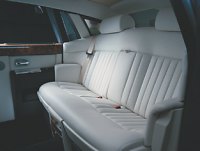 We
try the rear seat first. This is where the owners of Rolls-Royce most
likely
occupy. The rear seat locates higher than the front seats in order to
provide
a better forward visual which in turn gives the boss a commanding view.
Despite of rear-hinged doors, entry to the rear compartment is not as
easy
as RR claimed, because the doors are small. Once entered, you sit far
backward,
deep into the C-pillar, thus the ambience does not feel as airy as the
sheer space suggested. Those having tried Maybach’s airline-class
multi-adjustable
rear seats may be surprised that the one in RR is a fixed sofa, very
much
like a classical furniture. It looks far more graceful than the
Maybach’s,
if not ultimately as comfortable. We
try the rear seat first. This is where the owners of Rolls-Royce most
likely
occupy. The rear seat locates higher than the front seats in order to
provide
a better forward visual which in turn gives the boss a commanding view.
Despite of rear-hinged doors, entry to the rear compartment is not as
easy
as RR claimed, because the doors are small. Once entered, you sit far
backward,
deep into the C-pillar, thus the ambience does not feel as airy as the
sheer space suggested. Those having tried Maybach’s airline-class
multi-adjustable
rear seats may be surprised that the one in RR is a fixed sofa, very
much
like a classical furniture. It looks far more graceful than the
Maybach’s,
if not ultimately as comfortable.
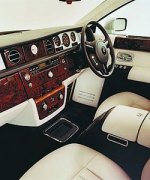 Now
forward to the front seat. Once again, the RR beats Maybach in terms of
quality and tasteful design. The high-mounted dashboard follows the
traditional
style of Rolls-Royce - from the leather, wood, chromed metal details to
the style of gauges, everything looks classic. There are some modern
items
however, such as a simplified version of iDrive system, but this time
BMW
is clever to hide it behind a wooden panel containing an analogue
clock.
You flip the panel to reveal the LCD screen. In this way, the RR keeps
its cabin looking classic and simple, a sharp contrast to Maybach. Now
forward to the front seat. Once again, the RR beats Maybach in terms of
quality and tasteful design. The high-mounted dashboard follows the
traditional
style of Rolls-Royce - from the leather, wood, chromed metal details to
the style of gauges, everything looks classic. There are some modern
items
however, such as a simplified version of iDrive system, but this time
BMW
is clever to hide it behind a wooden panel containing an analogue
clock.
You flip the panel to reveal the LCD screen. In this way, the RR keeps
its cabin looking classic and simple, a sharp contrast to Maybach.
Now
drive it.
Press the starter
button, the 6.75-litre V12 idles silently. Move off the line gently,
the
Phantom hardly transmit any noise to the cabin, thanks to the vast
noise
insulation, double bulkhead and double layer floor. The V12 spins so
smooth
and the ZF gearbox shifts so seamlessly that you nearly think this is
an
electric motor. In the Phantom, speed is not related to noise and
harshness
until 100mph. Only after then the wind-blocking shape generates a lot
of
wind noise.
The
Phantom rides
smoothly,
especially at low-speed and bumpy surfaces where competitors usually
suffer.
Its chassis is well sorted out. At first you might feel the tuning too
soft - the steering is very light, the car rolls too much and too early
in corners. But for this kind of cars such compromises is necessary in
order to obtain first-class ride quality and ease of driving. In fact,
the Phantom conceals its size quite well. Its steering is
communicative,
giving you confidence to place the car accurately. At 50:50, the car is
well balanced. At the limit, neutral gives way to gent understeer, so
it
is easy to handle. Of course, don’t compare it with Mercedes S-class,
because
the Rolls-Royce is much taller, heavier, bigger and ride softer.
After
decades of
falling,
we are glad to announce that Rolls-Royce is reborn. Phantom not only
helped
RR regain its position as the best luxurious car brand in the world but
it also passed the test for Rolls-Royce-ness. We just hope it could
look
more beautiful.
|
| The
above report was last updated on 26 Apr
2003. All Rights Reserved. |
Phantom vs Maybach
|
To be the
best luxurious car in the world, obviously, Rolls-Royce Phantom must
beat
Maybach first. Maybach is the super-luxurious arm of Mercedes.
Externally,
it looks like an enlarged S-class, although people criticized its front
end design differs little from Korean cars. Inside, the dashboard looks
like the S-class again, let you feeling that it is built down to cost.
Despite of the more expensive leather and wood used, the Maybach does
not
have the sense of occasion the Phantom has. It feels just too
mainstream.
The
Rolls-Royce
feels more
special, more like a royal saloon. Its exterior design is imposing,
certainly
not what you will appreciate immediately. Its interior follows the
tradition
of Rolls-Royce, styled and built with the best British craftsmanship.
The
retro-style rear sofa is lovely to look at. However, in terms of
sitting
comfort nothing could beat the Maybach, especially the long-wheelbase
Maybach
62. Maybach has more room, its large doors makes access easy, its
airline
first-class rear seats are multi-adjustable, even recline to become a
bed.
It has massager, heating and cooling incorporated. Rolls-Royce has none
of them. The Maybach also has countless of luxurious equipment and
therefore
a lot of controls throughout the cabin, a contrast to the "simple is
beautiful"
philosophy of RR.
Drive along
highway, the
Maybach continues to impress. Its twin-turbo V12 is noticeably more
powerful
than the Phantom's normally aspirated V12 thus overtaking is
breath-taking.
Both V12 are smooth and quiet, but the Mercedes' own 5-speed automatic
mates perfectly with the engine. Maybach has a better drivetrain.
Cruising
on
highway, the
Maybach has lower center of gravity thus high speed stability is
better.
The Rolls - like its name - just rolls too much to the like of keen
drivers.
However, Phantom is actually as secure and easy to control as Maybach
57
and is obviously more nimble than Maybach 62. Its chassis feels
noticeably
stiffer. Its rack-and-pinion steering is much more communicative than
the
recirculating ball system of the Maybach, giving the driver more fun
and
confidence.
Drive
around
town, the Rolls-Royce
reveals its biggest advantage. While the Maybach's air suspensions cope
badly with road irregularities and small intrusions, the Phantom rides
smoother and deal better with low-speed bumps. It also transmits less
suspension
noise, tire noise and engine noise to the cabin. In short, it is more
refined.
Which one is
the
most luxurious
car in the world? the Maybach is German interpretation of luxury -
strong
performance, good high speed handling, big interior, a lot of equipment
and gadgets, super-luxurious seats.... on the other hand, Phantom
represents
British luxury - it feels special and expensive. It handles competently
at low speed. It rides smoothly. It runs as quiet as Silver Ghost used
to be famous of. I guess most billionaires - most are old - will favour
the Rolls-Royce, while younger riches will choose the Mercedes. But I'm
afraid that is Mercedes S600. The point is, both Maybach and Phantom
are
not driver's car, unlike S600. |
| The
above report was last updated on 28 Apr
2003. All Rights Reserved. |
Phantom Drophead Coupe
|
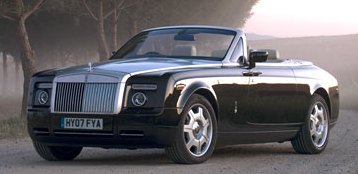 Although BMW
won't admit, sales of
Rolls-Royce Phantom has been running below expectation, although it is
clearly better than arch-rival Maybach. To recoup the substantial
investment made, a second model derived from the Phantom is being
introduced: Phantom Drophead Coupe. This is a 2-door, SWB convertible
version of the sedan. It is deemed to be the most expensive 4-wheel toy
to the riches. Each one is sold at £305,000, compare with the
sedan's £220,000 price tag. Also considerably more than the
£223,000 Bentley Azure, which is its closest rival. Despite that,
some 400 orders have been taken. That's equivalent to half of the sales
number of Rolls-Royce last year ! Although BMW
won't admit, sales of
Rolls-Royce Phantom has been running below expectation, although it is
clearly better than arch-rival Maybach. To recoup the substantial
investment made, a second model derived from the Phantom is being
introduced: Phantom Drophead Coupe. This is a 2-door, SWB convertible
version of the sedan. It is deemed to be the most expensive 4-wheel toy
to the riches. Each one is sold at £305,000, compare with the
sedan's £220,000 price tag. Also considerably more than the
£223,000 Bentley Azure, which is its closest rival. Despite that,
some 400 orders have been taken. That's equivalent to half of the sales
number of Rolls-Royce last year !
You may be curious to know how it could ask for so much money. The
answer lies in neither mechanicals nor performance, but the quality and
elegance feel it delivers. Look at the pictures, the Drophead Coupe is
undeniably a beautifully crafted masterpiece. Its chromed waterfall
grille curves gently towards a brushed stainless steel bonnet, then
followed by a chromed windscreen pillar that looks like a solid piece
of aluminum. The rear resembles a luxury yacht by using wooden surface
behind the rear seats. When the detailing is this beautiful, you can
almost forget the bulky profile of the car.
The Phantom's aluminum spaceframe chassis enables Rolls-Royce to
shorten its wheelbase and convert to cabriolet easily. Some 250 mm was
chopped off from the wheelbase in order to make it more agile and
reduce the loss of chassis rigidity. The latter is also helped by using
stronger aluminum extrusions and additional bracings. The Drophead
Coupe feels immensely stiff on the road, without any flexing or scuttle
shakes associated with cheaper cabriolets, even more impressive than
Bentley Azure. RR claims it is the world's stiffest open-top car, which
is unsurprising to me because Phantom is already the stiffest sedan in
the world.
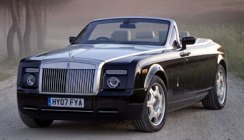 A gimmick or not, the two large doors are rear-hinged
(so-called "suicide doors") and electrically powered like the rear
doors of Phantom sedan. The cabin is very much the same as the sedan,
meaning a lot of wood, leather and aluminum and top build quality. You
sit as high as a lorry driver on the front seat, giving a commanding
view outside. The windscreen pillar is strengthened by triangular
windows at both sides to deal with roll over. As expected, the front
seats are comfortable and spacious, but rear seat space is very
disappointing for a car this big. If all occupants are 6-footers, those
at the rear will find limited legroom. The same goes for luggage space
– a miserable 315 liters. A couple of golf bags will be okay, but a
weekend's luggage may be too much, considering the amount of belongings
rich ladies normally take. A gimmick or not, the two large doors are rear-hinged
(so-called "suicide doors") and electrically powered like the rear
doors of Phantom sedan. The cabin is very much the same as the sedan,
meaning a lot of wood, leather and aluminum and top build quality. You
sit as high as a lorry driver on the front seat, giving a commanding
view outside. The windscreen pillar is strengthened by triangular
windows at both sides to deal with roll over. As expected, the front
seats are comfortable and spacious, but rear seat space is very
disappointing for a car this big. If all occupants are 6-footers, those
at the rear will find limited legroom. The same goes for luggage space
– a miserable 315 liters. A couple of golf bags will be okay, but a
weekend's luggage may be too much, considering the amount of belongings
rich ladies normally take.
With a boot so small, and the name "Drophead Coupe" (or cabriolet coupe
in our language), you might think it employs a state-of-the-art folding
metal roof. Sorry, it actually employs a conventional fabric roof.
Nevertheless, with 5 layers of insulation including a cashmere liner,
thermal and sound insulation are superb with the roof up. Top down,
however, the rear occupants suffer from some buffeting.
On the road, the Drophead Coupe keeps the magic carpet ride and
quietness of the sedan. The same 6.75-liter 48-valve V12 engine runs
silently like ghost. But now with the kerb weight increased to 2620 kg,
even 460 horsepower and 531 pound-foot of torque find difficulties to
deliver satisfactory performance. It is claimed to do 0-60 mph in 5.7
seconds, but in reality the time should be closer to 6.5 seconds,
slower than Bentley Azure's 5.9 seconds. Perhaps BMW should add a pair
of light-pressure turbochargers to solve the problem.
Handling is slightly more agile than the sedan, thanks to the shorter
wheelbase and slightly stiffer suspensions. The power assisted steering
is fingertip light. Surprisingly, it enables the driver to place the
big car easily in tight roads, a reflection of good chassis integrity.
However, push harder and you will feel the mass of the car from the
brakes and the early intervention of ESP. As everybody knows,
Rolls-Royce is not designed to be driven hard, but to be driven
effortlessly, enjoying the comfortable ride, quietness, quality and, in
the case of Drophead Coupe, elegant style, fresh air and sunshine.
|
| The
above report was last updated on 28 Jun
2007. All Rights Reserved. |
Phantom Coupe
|
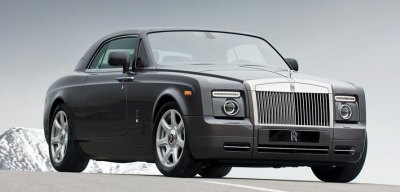
|
The buyers of Minis and 3-Series are
actually subsidizing the millionaires who buy Rolls-Royce...
|
BMW
sold around 1,000 Rolls-Royces last year, which is a small number
considering how much money it invested into the marque and building the
Goodwood factory. It goes without saying that it lost money on every
Rolls-Royce Phantom it sold, so ridiculously, the buyers of Minis and
3-Series are actually subsidizing the millionaires who buy Rolls-Royce
! To turn it into a profitable business, BMW wants RR to produce more
variants from the Phantom platform. This was kick-started by last
year’s Phantom Drophead Coupe and now continue with Phantom Coupe.
The Phantom Coupe was previewed by the 101EX concept two years ago. It
is based on the short-wheelbase Drophead Coupe but has an aluminum
hardtop replacing the soft top. The imposing / retro / bulky / ugly
styling remains loyal to its sibling, as is the unique suicide doors
that allow the millionaire’s ladies entry and exit gracefully. Its
cabin is almost identical to Drophead Coupe, which is a good news to
those putting top-notch quality and bespoke craftsmanship above style.
You still sit high above the ground, just like in a lorry, but this
lorry runs as quiet as phantoms and as smooth as magic carpets. New to
the cabin is a “starlight headlining”, which uses optic fibers to
realize 1600 light spots on the ceiling, simulating a starry night
view. I remember this gimmick was previewed by some concept cars a few
years back. In the production world, only this Rolls-Royce is
flamboyant enough to adopt it.
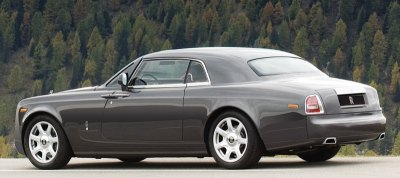
|
It does handles better than its
siblings, but it is still designed for relaxed cruising on the first
hand...
|
The
big coupe weighs some 2590 kg, only 30 kg less than the Drophead. Its
engine is still the same 460hp 6.75-liter BMW V12, therefore it
provides more or less than the same performance. I still doubt its 0-60
mph claims of 5.6 seconds, but its lower drag coefficient (although
still a forgettable 0.36) should be enough to raise top speed from the
convertible’s 149 mph to 155 mph.
Still, no one would buy Phantom Coupe for speed or handling. If you do
care about those qualities, you had better to go to the Bentley camp. A
Bentley Brooklands is not only more powerful (530hp and 774 lbft),
faster (184 mph, 0-60 in 5.0 sec) and sportier in corners, but also
significantly
cheaper (£230,000 vs £300,000). The Phantom Coupe does
handles better than its convertible and sedan siblings due to a
stronger chassis, stiffer suspension setting, heavier power steering
and a Sport button to speed up the automatic gearshift, but it is still
designed for relaxed cruising on the first hand. There is a clear
difference between a big luxury cruiser and a sports coupe.
Rolls-Royce hopes Phantom Coupe will add 200 orders to its sales book
every year. However, if I were a millionaire, I would definitely choose
the Drophead Coupe instead, because the convertible looks classier and
is more in line with the relaxing character of Rolls-Royce.
|
| The
above report was last updated on 28 Jun
2008. All Rights Reserved. |
|
|